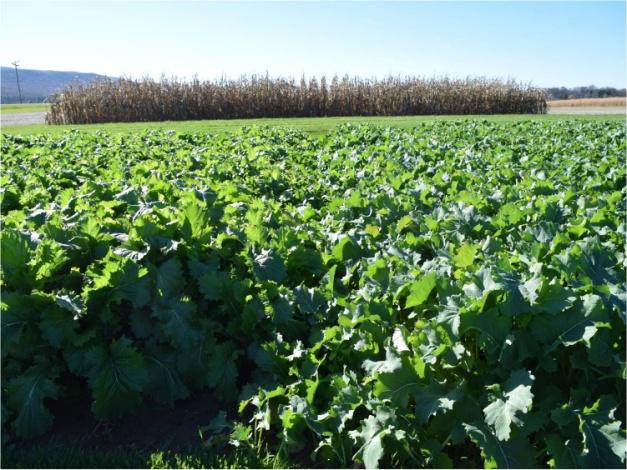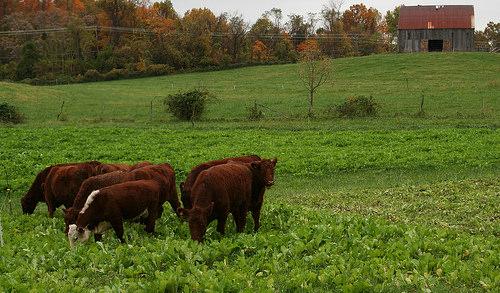Full report with figures and tables
Dr. Kathy Soder, USDA-ARS Pasture Systems and Watershed Management Research Unit, University Park, PA 16802.
Forage Brassicas are annuals that can be utilized as pasture during the spring, summer, and fall grazing seasons. Forage brassicas include varieties of rapeseed (rape), radish, turnip, swede, kale, and hybrids. Brassicas are quick maturing and can be grazed 60 to 120 days after planting, depending on species. Brassicas are able to produce up to 4 tons of DM/acre, and varieties of turnip, radish, and swede produce a highly palatable and nutritious tap-root that can be grazed during the last rotation of the season.

Brassicas can be established into an existing pasture sod by overseeding using a no-till drill. Prior to drilling, any remaining forage should be grazed or clipped to a height of approximately 3 – 4 inches. Brassicas can also be established into a prepared seedbed as a monoculture or as an annual mixture. However, a cultipacker should be used prior to planting to ensure proper planting depth. Plots should be fertilized at time of planting.
Brassicas are high quality feedstuffs that contain a high crude protein concentration, but also high net energy of maintenance and total digestible nutrient concentration. In dairy cattle, a mixture of turnip and forage sorghum was shown to increase milk yield, milk solids, and milk protein in cattle during summer compared with sorghum alone; however, a reduction in milk fat was seen. Brassicas have also been reported to increase average daily gain of beef cattle and sheep compared with other cool-season forages.
Forage brassicas are most commonly grazed. They can also be stockpiled, ensiled, or fed as greenchop. Due to the low dry matter, haying is not an option. Successful grazing management can be accomplished through strip or rotational grazing. Once forage has reached ~14”, animals can begin to graze. This can vary depending on species and variety used. If multiple grazings are desired, forage should not be grazed below a height of 6 – 8 inches. The root-bulb of turnip, radish, and swede can be grazed during the last grazing rotation of the season. If ensiled, a higher-dry matter forage should be included to ensure proper fermentation and reduce nutrient losses.

The diets of livestock with high production/growth rates (e.g. lactating dairy cattle, stockers) brassicas can be used as a daily feed ingredient (not exceeding 50% of daily dry matter intake). In other classes of livestock (e.g. non-lactating dairy cattle, cow-calf pairs), brassicas should be treated as a supplemental feed due to the high energy content of the forage and grazing should be limited to only a few hours/week.
Brassicas are an acquired taste and naive animals should be allowed limited access to brassicas for the first week of grazing. Brassicas are a high-moisture, low-fiber feedstuff and should not be more than 50% of the daily diet of any livestock. A high-fiber feedstuff should be included with brassicas. This can be achieved by giving access to low-quality hay, allowing access to perennial pastures, or planting brassicas as a mixture with other forages.
Brassicas are an excellent forage for cattle, sheep, goats, swine, and poultry. Equine species should not be fed brassicas due to concerns with toxicity. A trace mineral that includes copper and iodine should be fed to livestock to prevent possible deficiencies and small ruminants tend to be more susceptible than cattle. Sheep copper requirements are lower than that of other ruminants, thus copper supplementation of sheep should be done with care, especially if co- grazing multiple species. Nitrate poisoning and bloat have been reported in ruminants consuming only brassicas. Due to off-flavor, a withdrawal period of 4 hrs prior to milking and 7 days prior to slaughter is suggested; the withdrawal time will decrease as brassicas decrease as a percent of the total animal diet.